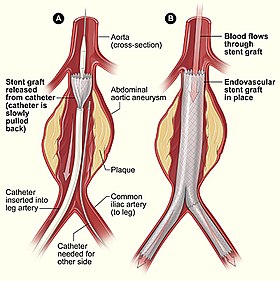| Minimally invasive procedure | |
|---|---|
 Endovascular aneurysm repair - example of minimally invasive procedure | |
| MeSH | D019060 |
| eMedicine | 938198 |
Minimally invasive procedures (also known as minimally invasive surgeries) encompass surgical techniques that limit the size of incisions needed, thereby reducing wound healing time, associated pain, and risk of infection. Surgery by definition is invasive, and many operations requiring incisions of some size are referred to as open surgery. Incisions made during open surgery can sometimes leave large wounds that may be painful and take a long time to heal. Advancements in medical technologies have enabled the development and regular use of minimally invasive procedures. For example, endovascular aneurysm repair, a minimally invasive surgery, has become the most common method of repairing abdominal aortic aneurysms in the US as of 2003. The procedure involves much smaller incisions than the corresponding open surgery procedure of open aortic surgery.[1]
Interventional radiologists were the forerunners of minimally invasive procedures. Using imaging techniques, radiologists were able to direct interventional instruments through the body by way of catheters instead of the large incisions needed in traditional surgery. As a result, many conditions once requiring surgery can now be treated non-surgically.[2]
Diagnostic techniques that do not involve incisions, puncturing the skin, or the introduction of foreign objects or materials into the body are known as non-invasive procedures.[3] Several treatment procedures are classified as non-invasive. A major example of a non-invasive alternative treatment to surgery is radiation therapy, also called radiotherapy.[4]
- ^ Sethi RK, Henry AJ, Hevelone ND, Lipsitz SR, Belkin M, Nguyen LL (September 2013). "Impact of hospital market competition on endovascular aneurysm repair adoption and outcomes". J. Vasc. Surg. 58 (3): 596–606. doi:10.1016/j.jvs.2013.02.014. PMID 23684424.
- ^ "Global Statement Defining Interventional Radiology". Journal of Vascular and Interventional Radiology. 21 (8): 1147–1149. Aug 2010. doi:10.1016/j.jvir.2010.05.006.
- ^ Dorland's (2012). Dorland's Illustrated Medical Dictionary (32nd ed.). Elsevier. p. 955. ISBN 978-1-4160-6257-8.
- ^ Daniel Albert (2012). Dorland's illustrated medical dictionary (32nd ed.). Philadelphia, PA: Saunders/Elsevier. p. 1573. ISBN 978-1-4160-6257-8.